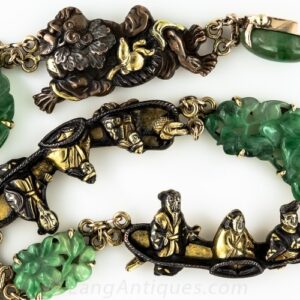
The reappearance of the Japanese in the world and their subsequent participation in the 1862 International Exhibition in London had a far-reaching influence on the aesthetics of art and design. The flowing lines so sensuously depicted in their artworks changed the direction of jewelry design beginning with the Art Nouveau period and their influence continued for decades. Menuki are small decorative elements (2 to 8 cm) composed of mixed metals and are used to decorate traditional Samurai sword handles. When sword-making ceased these beautiful little masterpieces were often adapted as jewelry elements.
The Jewelers’ Circular Keystone in 1922, defines menuki as:
…unique and beautiful ornaments for the sides of the hilt called menuki. The materials of which these pieces are made – besides shakudo and shibuichi, the characteristic alloys peculiar to the Japanese – comprise gold, silver, bronze, copper, iron, enamel (skippo), ebony, lacquer, ivory and bone.1
The book Collecting Japanese Antiques describes menuki as:
Menuki (metal ornaments) come in pairs and are often mirror images. The one on the sword facing away from the body was considered male and the other, facing inward, female. Menuki are hard to justify logically, yet they played a role in filling out the handle, an providing balance and beauty. Originally, the most admired subjects on menuki were dragons and flower lions (shishi) as they emblemize power, but stylized pine and other leaves, sea creatures, corn plants, and aubergines or peonies, family crests or vajra (symbolic thunderbolts from old Buddhism) are just as compelling artistically.2
Antique menuki continue to be available and are popular with collectors. Newly minted menuki and other traditional sword fittings which employ traditional designs but not necessarily mixed metal techniques are still being produced and sold today.
Sources
- Seton, Alistair. Collecting Japanese Antiques. North Clarendon, VT, Tuttle Publishing, Dec 13, 2013.
- The Jewelers’ Circular Keystone, October 4, 1922, Volume 85, Issue 1.